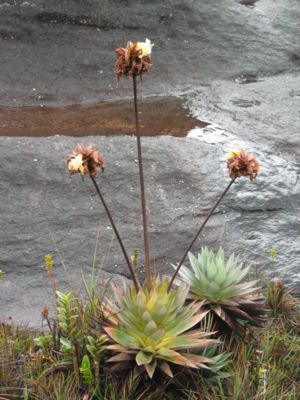Orectanthe
| Orectanthe | ||||||||||||
|---|---|---|---|---|---|---|---|---|---|---|---|---|

Orectanthe sceptrum on the Roraima tepui |
||||||||||||
| Systematics | ||||||||||||
|
||||||||||||
| Scientific name | ||||||||||||
| Orectanthe | ||||||||||||
| Maguire |
Orectanthe is the name of a plant genus of only two species in the family of xyridaceae . Francis Wall Oliver originallyassignedboth species to the genus Abolboda , but Bassett Maguire then described them as a separate genus Orectanthe . The genus is endemic to South American tepuis .
distribution
The Orectanthe species are endemic to the Roraima-Tepui , a 2810 m high table mountain in the triangle of Venezuela , Guyana and Brazil , or the Ptari-Tepui . The genus is widespread on the Tepuis and can be found on the territory of all three neighboring countries. It grows there on stony, nutrient-poor scree slopes at altitudes of 500 to 2700 m. The soil can also be extremely moist.
description
Plants of the genus Orectanthe are herbaceous plants of several years . The stem is short and caudiciform with a basal rosette of leaves ( Orectanthe sceptrum ) or tall with loose leaf spirals ( Orectanthe ptaritepuiana ). The leaves are pointed and hardened, with a red-brown edge.
With the flowering , long shoots form, on which one or two whorls of three bracts each form, on which the flowers sit, but which often remain empty. The bracts are much shorter than the sepals , and from broadly lanceolate to oval shape. The three sepals are uniform, lanceolate with a strongly curved lateral knee. The three petals have grown together to form a long lip. The flower color is yellow or reddish. There are three stamens that have grown together to form a tube, the filaments are longer than the anthers . The stylus is stretched and bent at the end, ending in a papillary scar .
The seeds mature in about 1.5 to 2 cm long oval, three-part seed capsules.
Systematics
Bassett Maguire separated the genus Orectanthe from the genus Abolboda in 1958 . The genus includes two types:
- Orectanthe sceptrum (Oliv.) Maguire : Southern Venezuela to Western Guiana.
- Orectanthe ptaritepuiana (Steyerm.) Maguire : Southeastern Venezuela to Guayana.
Individual evidence
- ^ Robert Kral: Xyridaceae in Flora of the Guianas. Koeltz Scientific Books, 1994, ISBN 3-87429-350-5 , pp. 25-27.
- ↑ a b Rafaël Govaerts (Ed.): Orectanthe. In: World Checklist of Selected Plant Families (WCSP) - The Board of Trustees of the Royal Botanic Gardens, Kew . Retrieved August 17, 2018.
Web links
- Vegetative Anatomy of Aratitiyopea Lopezi (Xyridaceae) (Article with nice cuts by Orectanthe)
